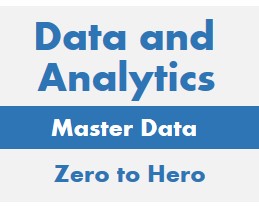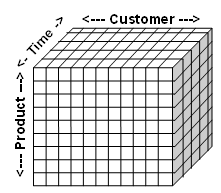


If you want to analyze data, then On-Line Analytical Processing (OLAP) is often the best way to organize the data. OLAP organization provides several benefits:
| Fast |
Data is organized for rapid query and analysis. The database structure uses efficiency multidimensional or tuned relational approaches. |
| Visual | Tools enable the analyst to navigate and view results through graphics such as: bar charts, pie charts and tree structures. |
| Multidimensional |
Supports "slicing and dicing" along multiple dimensions such as product, customer and location. In addition, supports "pivot" / "cross tabs" where the investigator changes the direction of the analysis. |
| Aggregation |
Supports both drill down to details as well as roll up. Some aggregations may be pre-calculated to save analysis time. This pre-calculation is where MOLAP provides value. See below. |
| Time Series | Supports trend analysis. Most data marts include a calendar dimension. This dimension supports time hierarchies: year, quarter, month, week, day of week, and day. |
| Ranking | Find the top, bottom or quartile members of a group, such as the top 10 most profitable products or the 10 lease profitable sales territories. |
| Clusters and Outliers | Gain an understanding of groupings of items with common characteristics (clusters) as well as item with unusual characteristics (outliers). |
| Complex Criteria | Gain an understanding of root causes and patterns by using complex criteria to look at meaningful slices of data. |
OLAP helps to visualize data as cube structures.

A cube is a multidimensional structure consisting of dimensions and measurements. Cells are the points where dimensions intersect and contain the measurements.
Dimensions provide the context for analysis which are used for labels on reports and selection criteria for queries. Dimensions answer questions like:
Cells supply quantitative information. Cells answers questions like:
An atomic measurement is one that is stored at the lowest level, such as an individual sale or a single receipt of goods. The benefit of atomic data is that it supports detailed analysis and atomic data can be summed as needed. The drawbacks of atomic data are that it takes more space to store and it requires time to aggregate into totals for analysis.
Aggregated data is a summation of atomic data. For example, sales by quarter and rejects by month are aggregations. The benefit is that query and analysis time are reduced. The drawbacks are that analysis detail can be lost and it is difficult to predict which aggregations the analyst will want to use.
Relational OLAP (ROLAP) uses commonly available relational databases to support multidimensional analysis. It has the advantages of:
Unfortunately, ROLAP has some disadvantages. These include:
Relational database vendors address some of these problems through the "Materialized View" which includes predefined joins and aggregations. This works well for cases where the joins and aggregations can be anticipated but falls down in cases where the need for aggregation can not be predicted. MOLAP was created to address those problems.
Multidimensional OLAP (MOLAP) addresses problems of multiple aggregations, sparse data and effective cube handling. It provides these benefits:
The Multi-Dimensional eXpressions (MDX) language created by Microsoft has become a defacto OLAP standard. An industry group, XMLA.org, promotes this approach. Examples of systems that implement MDX include:
Java OLAP (JOLAP) is an API that relies on the Common Warehouse Metamodel (CWM) standard. Oracle has implemented this standard at least in part.
The Hybrid OLAP is a combination of ROLAP and MOLAP. It seeks to create the "the best of both worlds".
Infogoal.com is organized to help you gain mastery.
Examples may be simplified to facilitate learning.
Content is reviewed for errors but is not warranted to be 100% correct.
In order to use this site, you must read and agree to the
terms of use, privacy policy and cookie policy.
Copyright 2006-2020 by Infogoal, LLC. All Rights Reserved.
